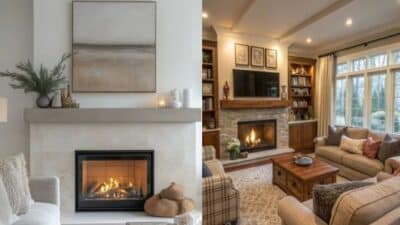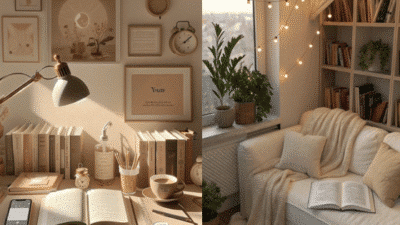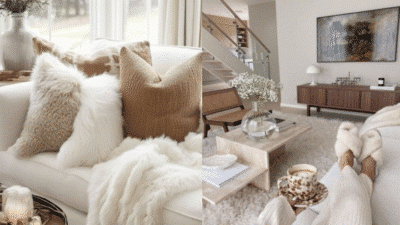A bed canopy can instantly transform your bedroom, adding both style and a sense of comfort. Whether you prefer a modern look or a more classic, romantic feel, there are many canopy ideas that suit different tastes and spaces. Choosing the right bed canopy can enhance your sleep environment while giving your room a unique focal point.
You can find simple ways to create your own canopy or explore more elaborate designs that fit your bedroom’s overall aesthetic. From sheer fabrics that softly diffuse light to heavy curtains that offer privacy, your choice of materials and style will define the atmosphere of your room.
This guide will help you discover the perfect canopy bed type and style, as well as tips on selecting fabrics and decorating to match your personal sense of design.
Key Takeways
- A bed canopy adds style and comfort to your bedroom.
- Fabric choice and design impact the room’s atmosphere.
- DIY and ready-made options offer versatility for every space.
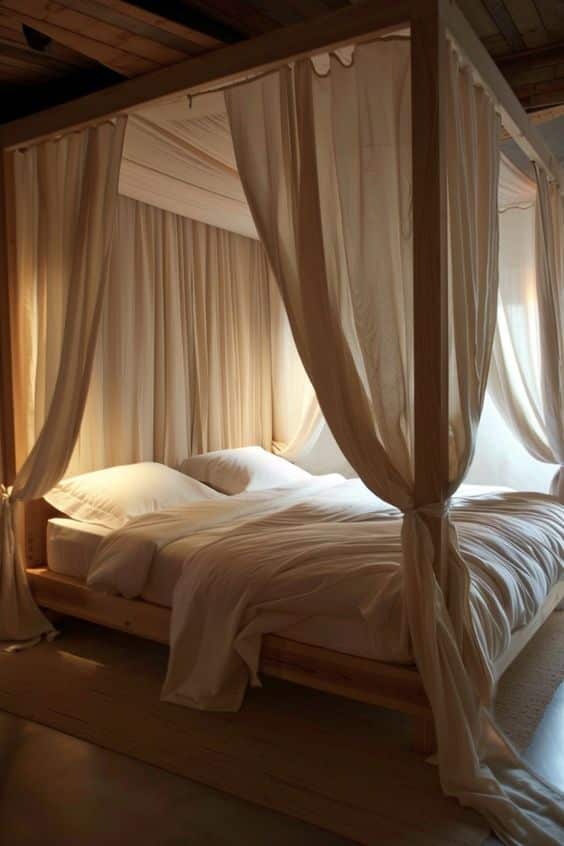
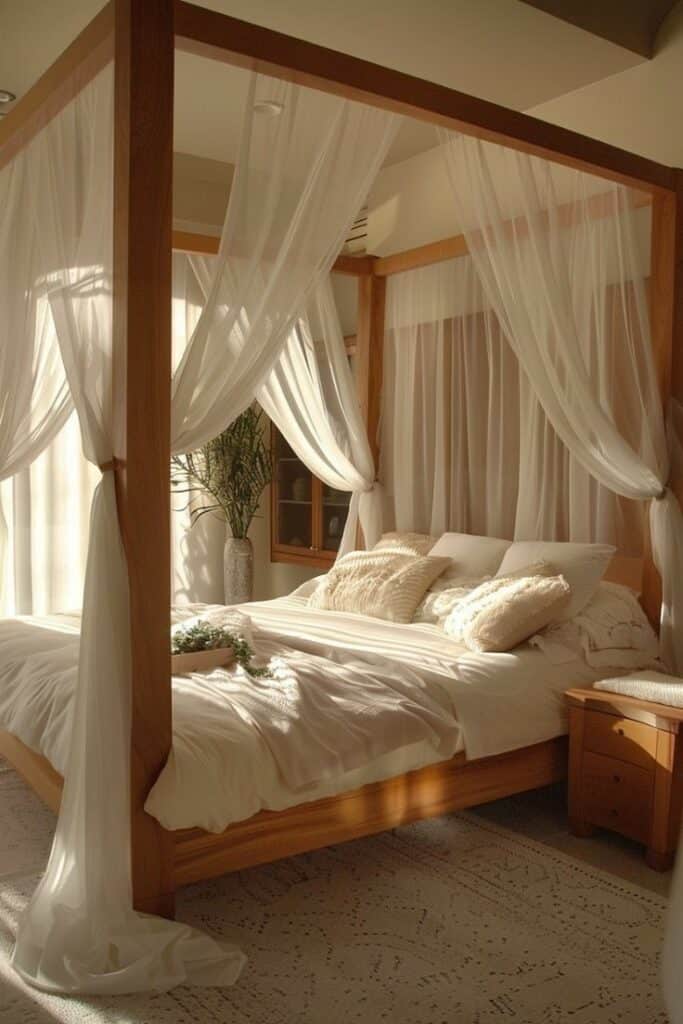
Types of Bed Canopies
Bed canopies come in various styles, each offering distinct visual appeal and functional benefits. Your choice depends on your room’s design, desired atmosphere, and practicality. Consider how each type frames your bed and interacts with space and lighting.
Four-Poster Bed Canopy
A four-poster bed canopy is built around a bed with four vertical posts at each corner. These posts support fabric drapes or curtains that can fully or partially enclose the sleeping area. This style is known for its strong structural presence and classic look.
You can use heavy drapes for privacy and warmth or lightweight fabric for a breezy feel. The four-poster canopy bed works well in traditional or vintage-inspired rooms. It also defines your bed as a focal point, adding architectural interest to your bedroom.
Crown Canopy
A crown canopy attaches to a circular or crown-shaped frame fixed above your bed. This creates a floating canopy effect, centering fabric or netting over your sleeping space without vertical supports on the bed itself.
This style is ideal for smaller rooms or those wanting an elegant, regal touch. The crown canopy is often used in French or vintage bedroom designs. It provides a softer, airier feel while still creating a defined space for sleep.
Corner Canopy
Corner canopies use fabric panels that hang from the four corners above your bed, often attached to wall brackets or ceiling hooks. The panels meet at the top or are tied back at the sides to frame the bed.
This type offers a balanced combination of openness and enclosure. You can adjust the fabric placement depending on whether you want more privacy or an open design. Corner canopies are versatile and fit many bedroom styles, from modern to eclectic.
Hoop Canopy
A hoop canopy is formed by suspending fabric from a circular or oval frame positioned above the bed. The frame hangs from the ceiling, allowing light fabric to drape loosely down and around the bed.
This canopy style gives an airy, whimsical feel without the heaviness of posts or large frames. You can use sheer or lightweight fabrics to soften the look and create a cozy nook. Hoop canopies suit contemporary, bohemian, or minimalist bedrooms where openness is key.
| Canopy Type | Support Structure | Style Influence | Best Use |
|---|---|---|---|
| Four-Poster | Four corner posts | Traditional, classic | Privacy, focal point |
| Crown | Ceiling frame | French, vintage | Elegant, floating effect |
| Corner | Wall or ceiling hooks | Versatile, modern/eclectic | Adjustable enclosure |
| Hoop | Suspended frame | Bohemian, minimalist | Light, airy feel |
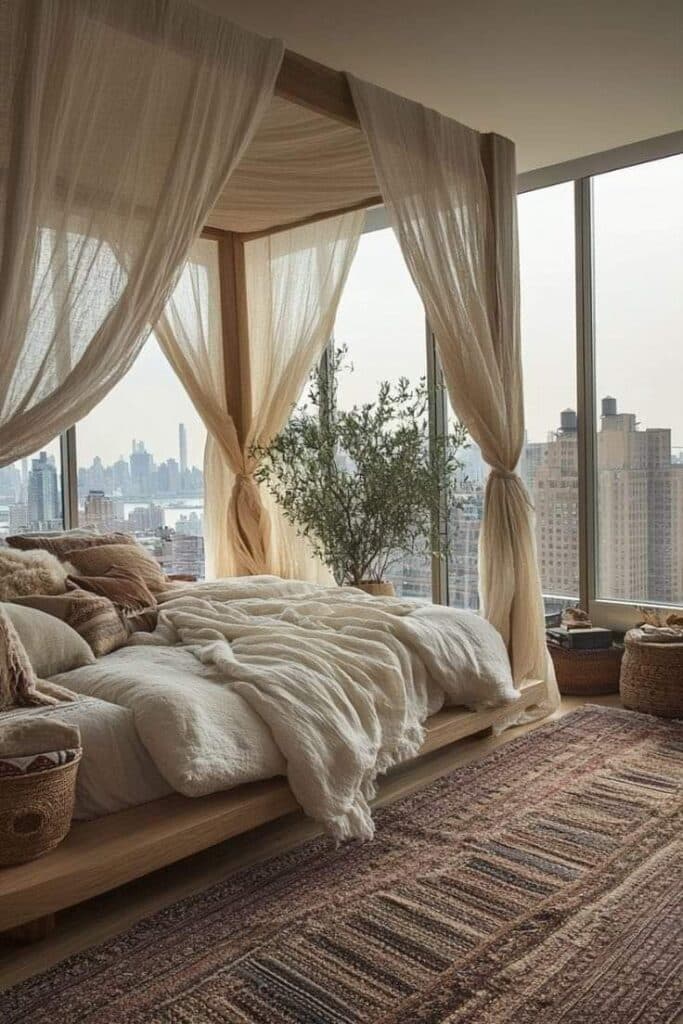

Popular Bed Canopy Styles
You can choose from various canopy bed styles that each bring a distinct atmosphere and function to your bedroom. Different materials, shapes, and decorative elements define these styles, allowing you to tailor the look and feel of your sleeping space.
Modern Canopy Bed
Modern canopy beds combine clean lines and sleek materials like metal or lacquered wood. You’ll often find designs without fabric drapes, emphasizing structure over ornamentation. This style works well with neutral color palettes and minimal accessories, supporting a contemporary, streamlined look.
If you prefer fabric, opt for sheer or lightweight curtains that add softness without clutter. Many modern canopy beds feature low-profile frames and elevated canopies that create a floating effect. This style suits urban apartments or minimalist interiors focused on open space.
Rustic Canopy Bed
Rustic canopy beds use natural wood with visible grain, knots, and rough finishes. They convey warmth and a handcrafted feel, ideal if you want a cozy, grounded bedroom. You’ll encounter thick wooden posts and earthy, muted colors in linens or drapes.
You might add heavy, textured curtains like burlap or linen to reinforce the rustic vibe. This style pairs well with farmhouse or cottage decor, acting as a centerpiece that ties together other natural elements in your room. Its robust appearance fits well in less formal, inviting spaces.
Boho Chic Canopy
Boho chic canopy beds prioritize eclectic and artistic touches. You can use macramé or patterned fabrics to hang loosely from the frame. Colorful, layered textiles in earthy or jewel tones boost visual interest and texture.
You should incorporate decorative elements such as tassels or fringe to enhance the casual, creative atmosphere. Boho chic blends vintage with handmade accents, perfect if your style embraces individuality and warmth. This canopy style allows flexibility in fabric choices and layering to express your personality.
Minimalist Canopy Bed
Minimalist canopy beds emphasize simplicity and function with almost no extraneous decoration. You’ll find geometric frame shapes, often in monochromatic shades like black, white, or gray. Fabric use is minimal or entirely absent.
The focus is on clean space and visual calm. If you use curtains, select lightweight, neutral fabrics that avoid clutter. This style suits those who want a subtle canopy presence that enhances openness without distraction. It fits perfectly in small or modern bedrooms where simplicity is paramount.
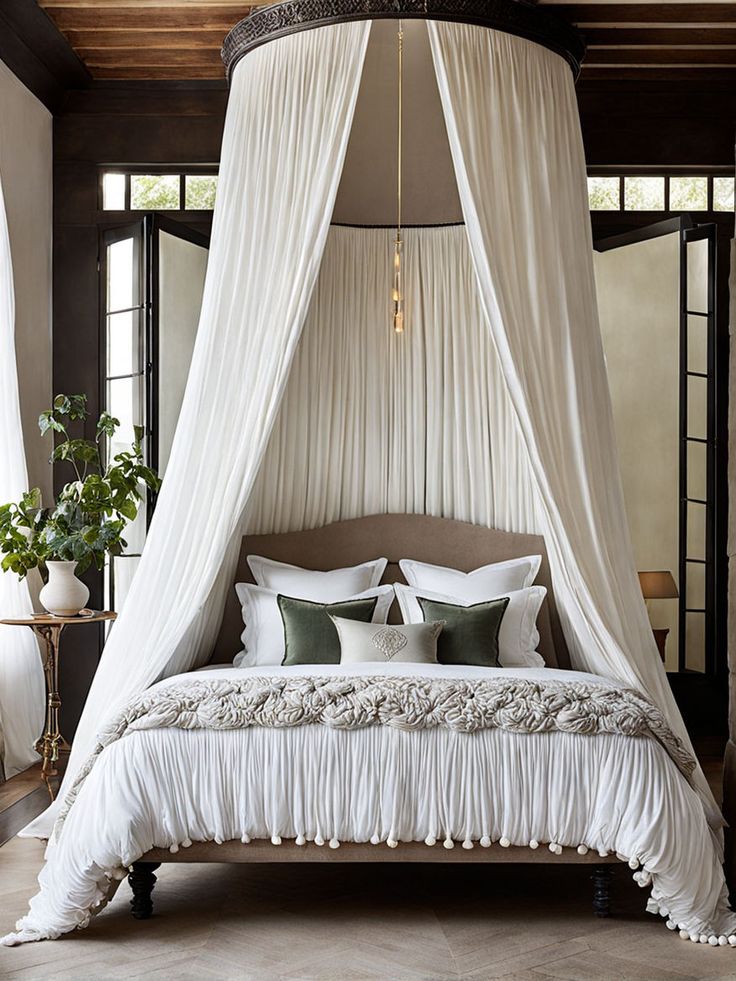
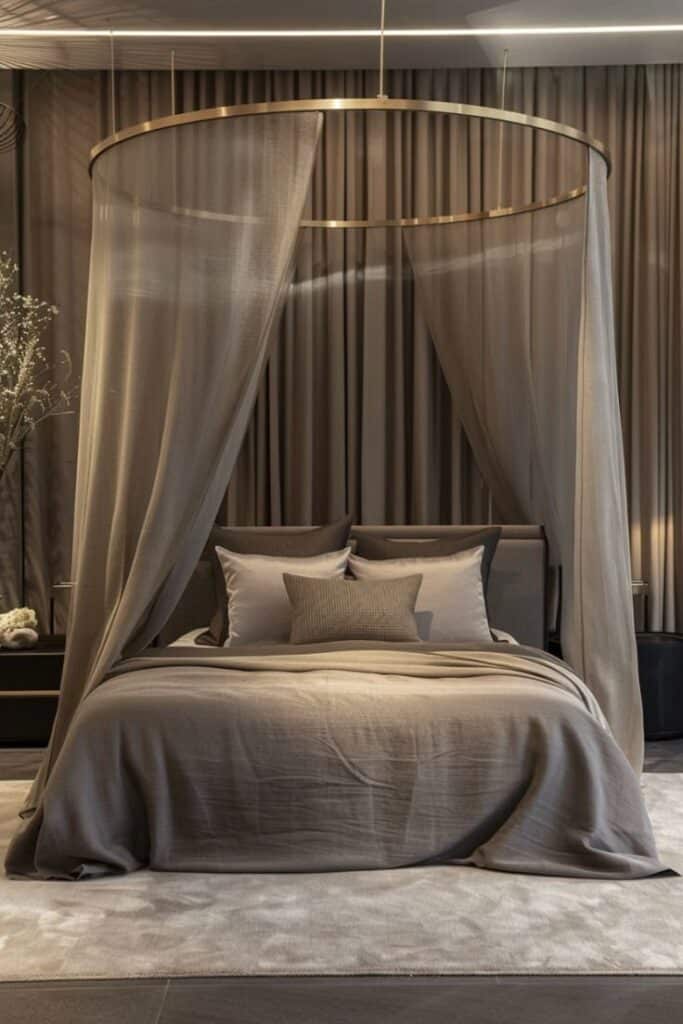
Choosing Fabrics and Materials
When selecting fabrics for your bed canopy, consider both the look you want and how the material will function in your space. Focus on fabric weight, opacity, and texture to create the desired atmosphere, whether light and airy or warm and cozy. The right choice will balance aesthetics with practicality.
Sheer White Curtains
Sheer white curtains are a classic option that adds brightness and a sense of openness to your canopy bed. The lightweight fabric lets natural light filter through while still offering a degree of privacy. Sheer fabric is typically made from materials like voile or chiffon, which drape softly and move gently with airflow.
In a bedroom with limited natural light, sheer white curtains can brighten the space without overwhelming it. You can layer them with heavier curtains for added versatility. Maintenance is straightforward because sheer materials often wash easily and dry quickly.
Neutral Curtains
Neutral curtains in shades like beige, taupe, or soft gray provide a subtle, versatile backdrop for your bed canopy. These colors blend with various decor styles and create a calm, understated effect. You’ll find neutral fabrics in cotton, linen, and blends that are durable yet soft.
Choosing neutral curtains allows you to add accent colors elsewhere without clashing. They also tend to hide minor stains better than pure white options. When selecting a neutral fabric, consider one with a slight texture; this adds depth without disrupting simplicity.
Drapery Options
The style and weight of drapery will define the personality of your draped canopy. Heavier fabrics like velvet or thick linen offer warmth and structure, ideal for a cozy or luxurious feel. Lighter drapery, such as gauze or silk blends, creates softness and movement.
Consider whether your canopy will be fully closed for privacy or mostly decorative. Fabric patterns range from bold prints to subtle weaves. Bold patterns add visual interest but require coordination with room decor. Keep your space’s light exposure and ventilation needs in mind when choosing drapery weight.
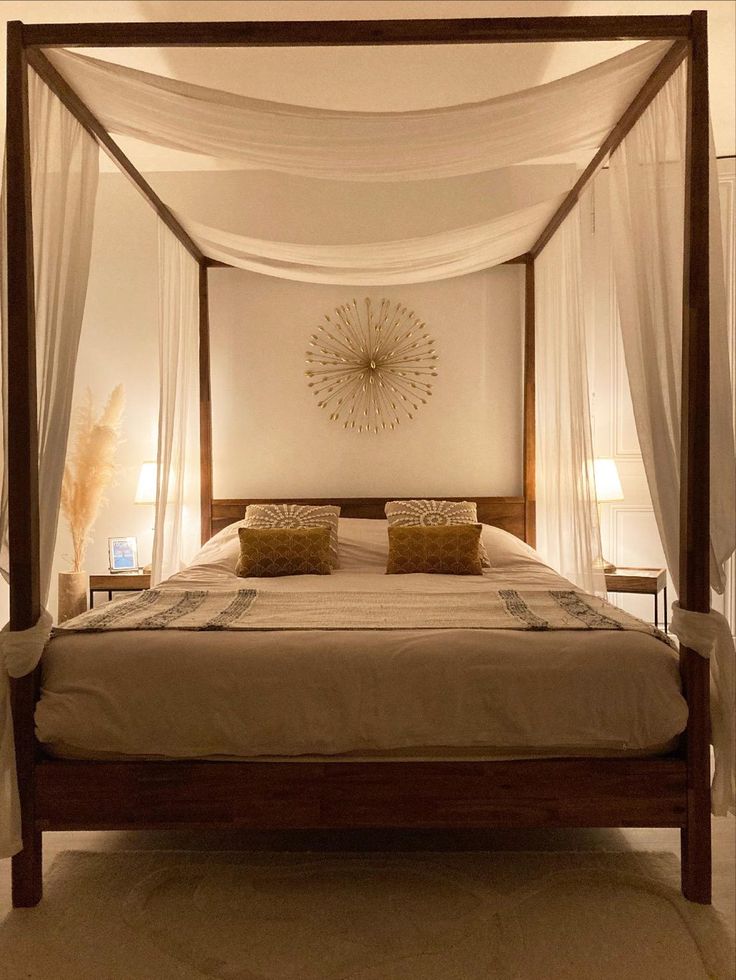
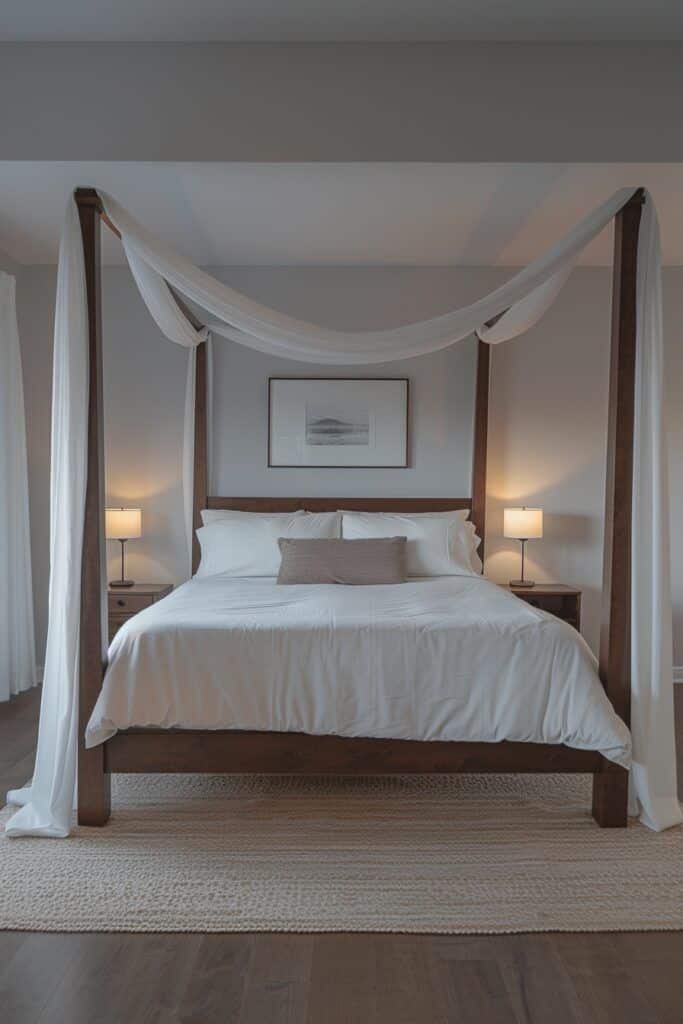
DIY Bed Canopy Ideas
You can easily transform your sleeping space with simple materials and creative touches. These ideas focus on practical, stylish options that suit various skill levels and enhance your bedroom ambiance.
Easy DIY Bed Canopy
A straightforward way to create a bed canopy is by using lightweight fabric and hooks. Start by measuring the space above your bed, then attach ceiling hooks or use a tension rod to hang the fabric.
Choose breathable materials like cotton or voile for a soft look that also allows airflow. You can drape the fabric loosely for a relaxed vibe or secure it tightly for a modern, clean appearance. This project requires minimal tools—generally just a drill or screwdriver—and basic sewing may help for finishing edges.
This simple approach provides privacy and a cozy feel while avoiding heavy construction. You can change the fabric easily to update your bedroom style.
DIY Hoop Canopy
A hoop canopy uses an embroidery hoop or metal ring as the frame for hanging fabric. To start, select a hoop size that fits your bed dimensions and cover it with fabric or leave it bare.
Attach sheer or lightweight fabric around the hoop, letting it cascade down on all sides of your bed. Suspend the hoop from the ceiling with rope or chains anchored in a single hook. This creates a floating effect and encloses your bed softly.
This option is ideal if you want a minimalist, elegant canopy without bulky supports. Materials are inexpensive, and assembly is quick, making it a great project if you want a refined look with minimal clutter.
Fairy Lights and Accessories
Incorporate fairy lights into your DIY bed canopy for ambient lighting that softens the space. Wrap battery-operated or plug-in string lights around the canopy frame or tuck them inside the fabric folds.
You can also add lightweight accessories like tassels, ribbons, or lace along the edges to personalize your canopy. These small additions boost texture and visual interest without weighing down the structure.
Be sure to secure lights safely and avoid overheating by choosing LED strands. This enhancement works well with both hoop and traditional fabric canopies, giving your bedroom a delicate yet inviting glow.
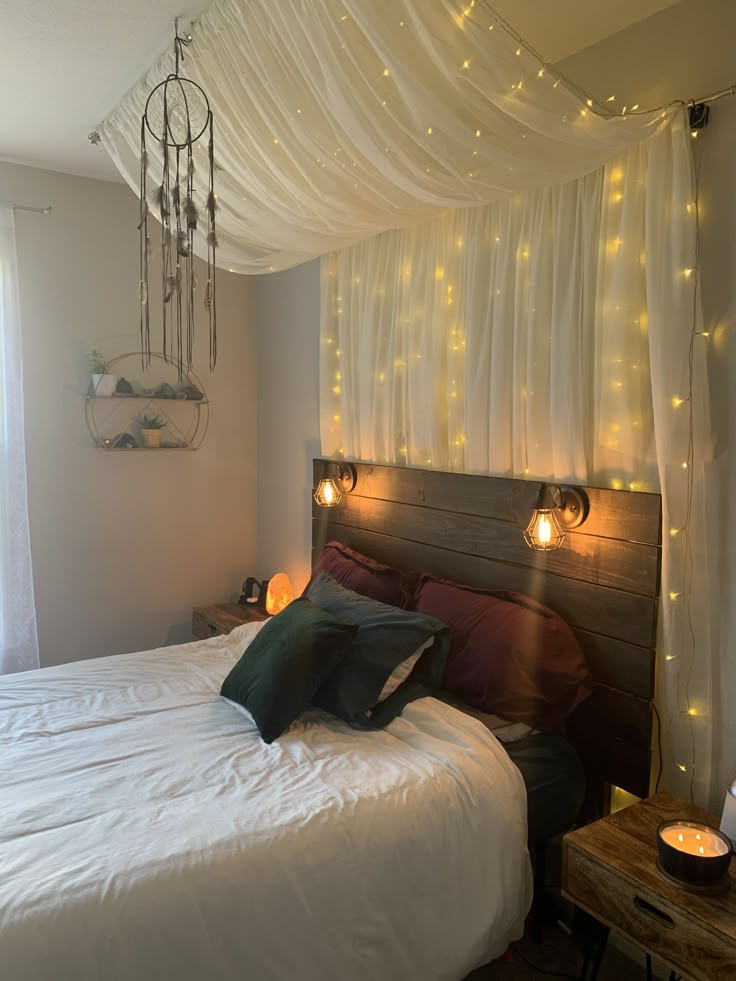
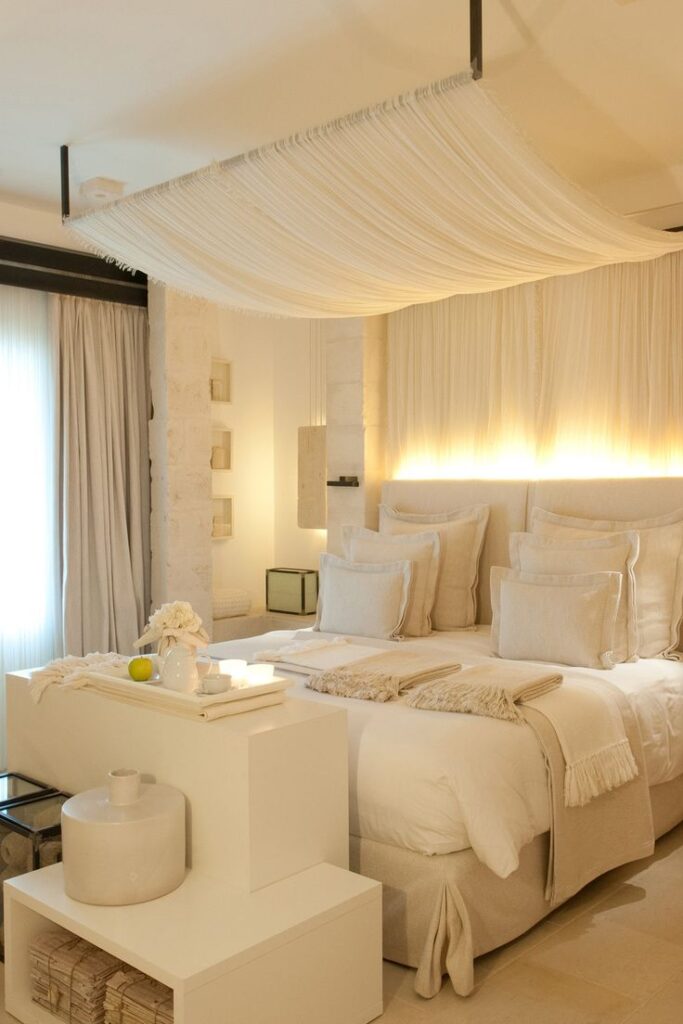
Color Schemes and Decorative Touches
Choosing the right colors and decorative elements can elevate the look and mood of your canopy bed. Consider how light and fabric textures interact with color to create either a serene or vibrant space. Small accents can also enhance warmth and style without overwhelming the room.
All-White Canopy Bed
An all-white canopy bed creates a clean, airy environment that brightens your bedroom. Use sheer white curtains to frame the bed softly, allowing natural light to filter through while maintaining privacy. Pair white linens with subtle textures like linen or cotton to avoid a flat look.
White walls and minimalist furnishings complement this scheme well, making the canopy the room’s focal point. You can add metallic or glass bedside lamps for subtle contrast without disrupting the monochrome harmony. This approach works best if you prefer a calm, timeless style that feels spacious and uncluttered.
Yellow Canopy Bed
Yellow adds warmth and a lively energy to your canopy bed while still maintaining a welcoming atmosphere. Opt for drapes or bedding in muted shades like mustard or pastel yellow to avoid overpowering the room.
Balancing yellow with neutral walls or furniture prevents the color from becoming too intense. Accents such as gold candle holders or wooden nightstands pair naturally with yellow, enhancing its richness. This color scheme works well if you want your canopy bed to feel bright but cozy and grounded.
Cozy Feel Accents
To give your canopy bed a cozy feel, focus on layered textures and soft decorative touches. Add plush throw pillows in warm tones, like deep browns or rich reds, paired with a thick knit blanket or faux fur throw.
Consider macramé or woven elements for a handcrafted look that adds visual interest and texture. Soft lighting from string lights or fabric-covered lampshades increases the sense of intimacy. These accents make the bed inviting for relaxation without complicating your overall design.
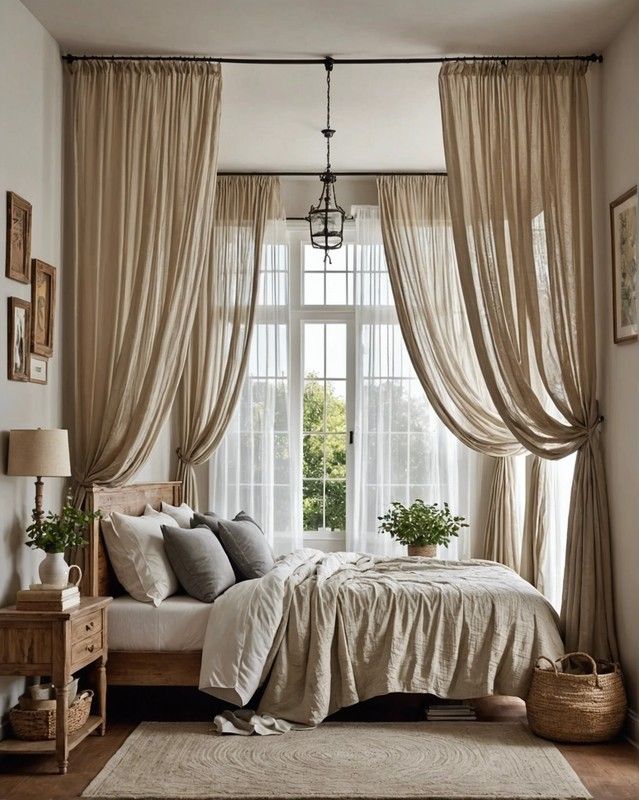
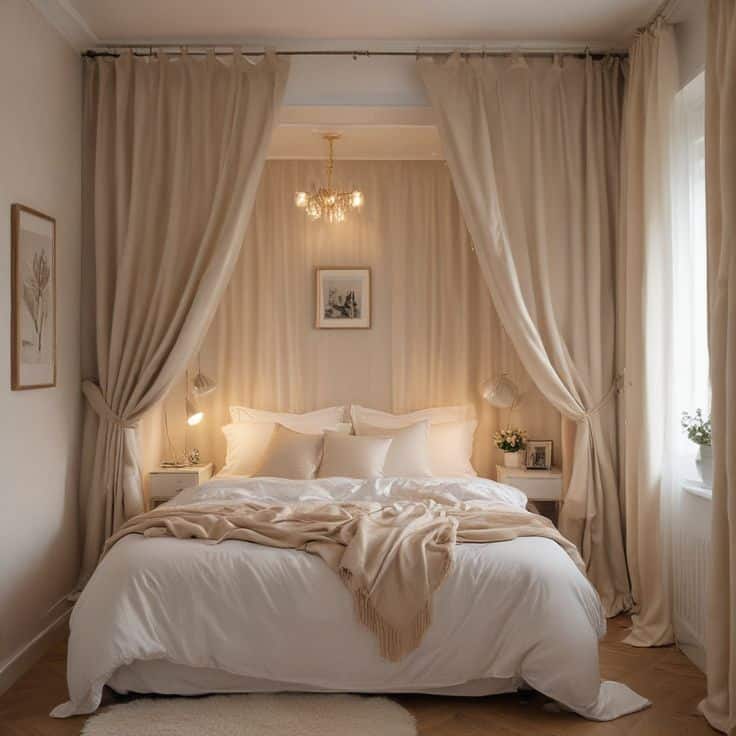
Incorporating a Bed Canopy in Bedroom Design
When adding a bed canopy to your bedroom, consider how the frame style and room layout affect both function and aesthetics. Choosing the right canopy bed type can define the room’s atmosphere, while smart space planning maximizes comfort and flow.
Pairing with Antique Beds
Antique canopy beds bring a classic, elegant touch to any space. Their often intricate woodwork and sturdy frames make them a focal point that pairs well with rich fabrics like velvet or lace. You can emphasize heritage by selecting muted or jewel tones to drape over the frame.
Keep surrounding décor complementary but not overwhelming. Use vintage bedside tables and soft lighting to enhance the antique look without cluttering the space. The heavy structure of antique beds usually requires a room with ample ceiling height to avoid a cramped feeling.
Finally, maintain balance by allowing enough open air around the bed for comfort. This prevents the canopy from overpowering smaller rooms while highlighting its design craftsmanship.
Metal Canopy Bed Integration
Metal canopy beds offer a modern, minimalist option with clean lines and versatile finishes like matte black or brushed nickel. These beds work well with simple canopy designs where fabrics can be lightweight, sheer, or even minimal with no fabric at all.
You can create contrast by mixing metallic frames with soft textiles in neutral or pastel palettes. The durability of metal frames also allows for creative additions such as string lights or hanging plants.
Keep your bedroom design uncluttered to emphasize the sleek feel of metal. Metal canopy beds fit well in contemporary and industrial styles but can soften with textiles to suit bohemian or eclectic tastes.
Space Planning Tips
Integrating a canopy bed effectively demands thoughtful space planning. Measure your room and bed frame carefully, allowing at least 18-24 inches of clearance on either side for ease of movement.
Ensure the canopy height suits your ceiling. A frame too tall can overwhelm low ceilings, while a shorter canopy may look disproportioned in a large room.
Consider lighting carefully. A canopy can block overhead light, so use bedside lamps or integrated string lights to ensure even illumination. Lastly, think about your room’s main functions and balance the canopy’s presence to avoid making the space feel crowded.
- 418shares
- Facebook0
- Pinterest418
- Twitter0

